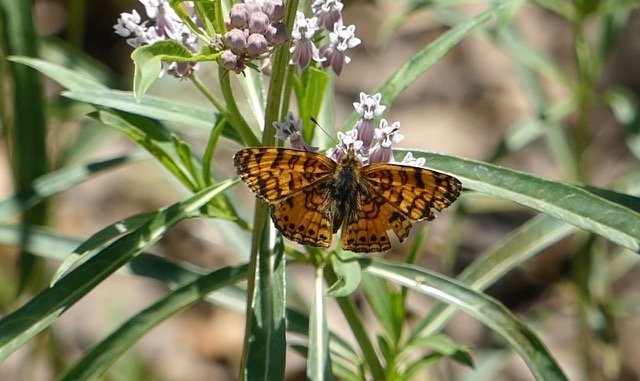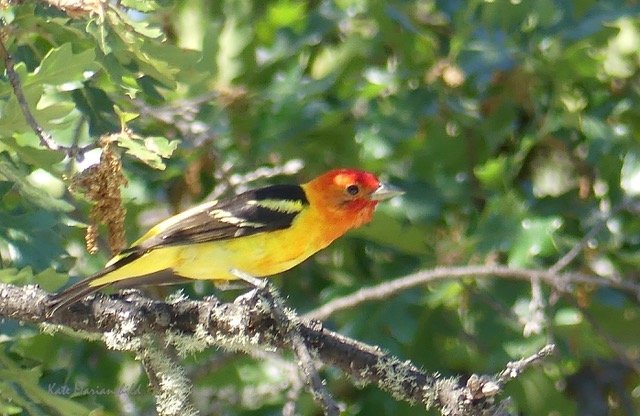Birds will be singing and nesting, flowers will be blooming, and butterflies will be fluttering by. We will meander quietly through Emandal’s 1,000 acres of oak and riparian woodlands, looking, listening, and learning about the social structures, behaviors, anatomical marvels, and interrelationships of the flora and fauna we will encounter. Using close-focus binoculars, we will delight in gloriously magnified flowers, dragonflies, and lizards. We will study bushtit nests and woodrat mansions. We will identify and discuss the ecological roles of oaks, willows, and ceanothus; northern flickers, hummingbirds, and dippers; caterpillars, frogs, and squirrels. We may even see and learn about beavers, mink, otters, foxes, coyotes, bears, and/or eagles!
Northern Flicker
Each morning, after a delicious breakfast, we will head out around 10 a.m. with snacks and/or lunches, and will return by 2:30 or 3 pm. The pace will be slow and we will rarely cover more than a mile in a day. We will sometimes be off-trail with uneven footing, such as the rocky riverbed, so walking sticks may be helpful. After returning from our rambles each day, we will have free time for swimming, hiking, reading, studying, napping, socializing, singing, creating art, or …
You will be welcome to draw, paint, write, or create art in other ways, but artistic expression will not be required. Please bring your own supplies for your preferred art forms.
And be aware that certain risks, such as ticks, rattlesnakes, and poison oak, are inherent in any outdoor setting in California’s foothills
Kate Marianchild is the author of Secrets of the Oak Woodlands: Plants and Animals Among California’s Oaks. In this classic of California nature writing, Kate weaves scientific facts, anecdotes, and humor into intimate portraits of twenty-two plant and animal species, portraying their unique behaviors, adaptations, and interrelationships. As a writer, presenter, and nature guide, Kate is known for her riveting explanations and contagious enthusiasm. Participants come away from her guided walks with “new eyes” for everything that flies, walks, swims, burrows, and blooms.
Essential Items for our Walks
Daypack
Water
Hat
Comfortable closed-toe shoes with good traction, ideally shoes that burs won’t stick to. (Sturdy sandals with traction might be OK on some days, but not all).
Fragrance-free sunscreen (if you use sunscreen).
A piece of lightweight fabric to sit on, at least 4’ x 6’, for partial protection against ticks when we are sitting. (Part of a bedsheet works well––inexpensive at a thrift store).
Several pairs of socks long enough to tuck your pant legs into––another partial protection from ticks.
Close-focus binoculars, if you have them or can borrow them. (I highly recommend that you have your own pair rather than depending on sharing with someone else. Often we have just a moment or two before an insect or lizard disappears!) You can purchase them online, including from my website (www.katemarianchild.com), or buy them once we’re at Emandal and save on shipping). The current price is $134. Please bring cash or check as internet is sketchy at Emandal.
Lunch and snack foods.
Containers for carrying snacks and/or lunch..
Any medicines you might need, including an epipen if you are subject to anaphylactic shock. (We will be about 45 minutes on a dirt road from any stores, gas stations, or medical facilities.)
Toilet paper and plastic ziplock bag for used toilet paper.
OPTIONAL ITEMS FOR OUR WALKS AND OTHER ACTIVITIES
A copy of my book, Secrets of the Oak Woodlands: Plants and Animals Among California’s Oaks.
Field guides of your choice (we will divvy them up so no one is carrying more than one in their pack).
A small notebook and pen or pencil for taking notes.
Birding binoculars (Close-focus binoculars are capable of focusing at any distance, but they don’t have the wide field of vision that birding binoculars have. The wider field of vision makes it easier to find birds high up in distant trees or sky). I like to wear both simultaenously, with a binocular harness to take the weight of the heavier birding binocs off my shoulders. Harnesses are available online…a few years ago they cost about $20.)
A cell phone with identification and documenting apps such as Merlin, Seek, iNaturalist, and eBird.
Walking sticks if you need them.
1-2 lightweight containers for “treasures”––acorns, feathers, galls, leaves, already-dead butterflies, beetles, or dragonflies, etc.
Folding knife for cutting things open.
Camera














